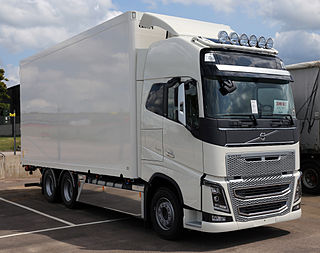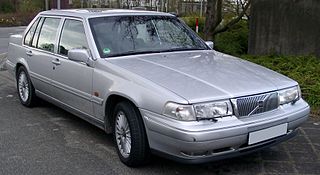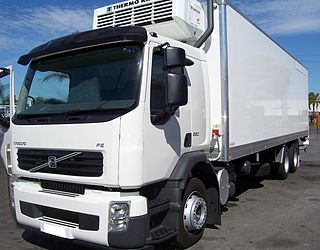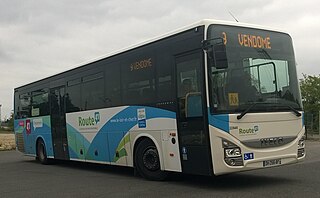Scammell Lorries Limited was a British manufacturer of trucks, particularly specialist and military off-highway vehicles, between 1921 and 1988. From 1955 Scammell was part of Leyland Motors.

The Volvo 700 series is a range of executive cars produced by the Swedish manufacturer Volvo Cars from 1982 to 1992. The 700 series was introduced in 1982 with the luxurious 760, followed two years later by the lower priced 740 which capitalized on the prestige attained by the very similar 760. The 700 series was then gradually replaced, beginning in 1990, by the 900 series. The 700, designed by Jan Wilsgaard, was originally to have been a replacement for the 200 series, but production of that model continued until the early nineties. The expensive 780, a Bertone-designed coupé version, entered production in 1986 and departed without a direct successor only four years later.

The Lancia Kappa or Lancia k is an executive car manufactured and marketed by Italian manufacturer Lancia from 1994–2000, with saloon, estate, and coupé variants — sharing platforms with the Alfa Romeo 166. The Kappa has a front-engine, front-drive, five passenger, left-hand drive design.

The Isuzu Forward is a line of medium-duty commercial vehicles manufactured by Isuzu since 1970, following the earlier TY model which occupied the same slot in the market. All F-series trucks are cab over designs and the cabin comes fully built from the factory. Most models come with a diesel engine; but, some markets get CNG derivatives as well. The F-series is available a variety of cab styles, engines, 4WD or 2WD depending on the market it is sold. While Isuzu's main plant is in Japan, these trucks are locally assembled from CKD kits in numerous countries.

The Isuzu D-Max is a pickup truck manufactured since 2002 by Isuzu Motors. A successor of the Isuzu Faster/KB, the first and second-generation model shares its platform with the Chevrolet Colorado. The third-generation model shares its platform with the third-generation Mazda BT-50, which is produced in the same Isuzu plant in Thailand.

The Hino Ranger is a medium or heavy duty commercial truck produced by Hino Motors since 1964. In the domestic market, its principal competitors are Isuzu Forward, Nissan Diesel/UD Condor and Mitsubishi Fuso Fighter.

The Volvo FH is a heavy truck range manufactured by the Swedish company Volvo Trucks. It was originally introduced in late 1993 as the FH12 and FH16. FH stands for Forward control High entry, where numbers denominate engine capacity in litres. The FH range is one of the most successful truck series ever having sold more than 400,000 units worldwide.

Volvo F10, F12, and F16 are a series of trucks manufactured by Volvo Trucks between 1977 and 1993. Volvo manufactured about 200,000 trucks in this series between 1977 and 1993.

The Volvo FM is a heavy truck range produced by the Swedish company Volvo Trucks. It was originally introduced as FM7, FM10 and FM12 in 1998. FM stands for Forward control Medium height cab, where the numbers denominate an engine capacity in litres. As of 2005 the engine size is no longer added to the model denomination. The FM range is a multipurpose truck range for distribution, construction and on highway/off highway transport duties. In 2013, Volvo Trucks announced an updated, Euro VI version of the Volvo FM.

The Volvo 900 Series is a range of executive cars produced by the Swedish manufacturer Volvo Cars from 1990 to 1998. The 900 Series was introduced in 1990 to replace the 700 Series from which it derived. Prior to the end of its production, the 960 was renamed as the Volvo S90 (saloon) and Volvo V90 (estate), and the 940 was renamed 940 Classic, becoming the last rear-wheel-drive cars from Volvo, until the 2023 Volvo XC40.

The YD engine is a 2.2 and 2.5 L inline-four diesel engine from Nissan. It has a cast-iron block and aluminium head with chain driven twin overhead camshafts. The engine shares much of its architecture with the QR petrol engine.

The Volvo FE is a medium duty truck produced by Volvo Trucks Corporation since 2006, now in its second generation. The FE is available in various rigid versions and a tractor version spanning three weight classes.

The IVECO Bus Crossway is an urban and intercity bus produced by IVECO Bus since 2006.

The M915 is a tractor unit used for line haul missions by the United States Army. Designed for use on improved roads it does not have a driven front axle.
The Steyr 90 series is a cab over truck originally introduced in 1968, built by Steyr-Daimler-Puch AG in Steyr, Austria. It has a tilting cab and is of a distinct shape, which survived into the twenty-first century with China's Sinotruk. In 1978 the facelifted Steyr 91 replaced the 90, and it was in turn replaced by the redesigned Steyr 92 in 1986. Considering its comparatively low production numbers an unusually wide range of models and configurations were available, necessitated by Steyr's dominance of the Austrian truck market in the period - in 1980 about 35% of trucks on the roads there were made by Steyr. It was known as Steyr 800 in Japan.

The Volvo I-Shift is an automated manual transmission developed by Volvo subsidiary Volvo Powertrain AB for Volvo Trucks and Volvo Buses, with 12 forward gears and 4 reverse gears. It became available for trucks in 2001 and later buses in 2004.

The Mack MC/MR series, also known as the "Cruise-Hauler", is a cabover truck first introduced in 1978. It is of a distinct "set back front axle" design, with the driver compartment mounted ahead of the front axle and with a large, flat, divided windscreen covering almost half of the truck's frontal aspect.

The Iveco EuroCargo is a range of medium-duty trucks produced by the Italian manufacturer Iveco since 1991. The EuroCargo occupies a place between the light Daily and the heavy Stralis in Iveco's lineup. The EuroCargo replaced the Zeta model produced in the 1970s.

The Mack Granite is a series of heavy duty and severe service trucks built by Mack Trucks. It has a long, low-profile hood and a high-visibility cab. Designed as straight trucks for local construction, waste removal, and other vocational jobs, it is also available as a semi-tractor. Introduced in 2001, it remains in production as of today.

The Mack TerraPro is a series of heavy duty and severe service trucks built by Mack Trucks. They are a forward control cab-over-engine type, where the driver sits in front of the axle. A flat front has two large windshields. A spotting feature is small notches in the lower inside of the windshields. It is used in refuse service and for construction concrete pumps.




























